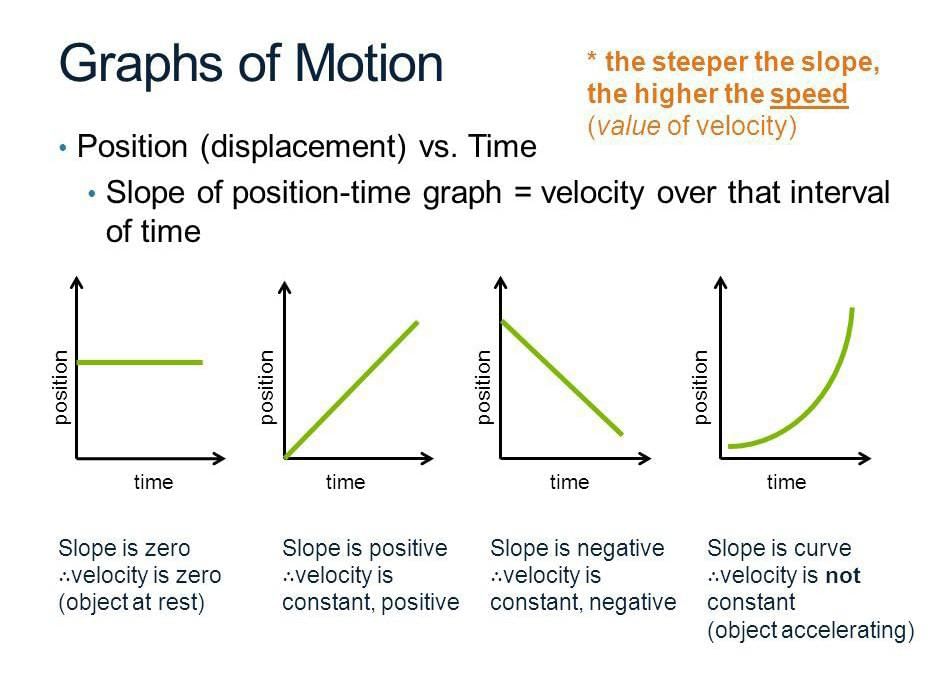Class 12 Exam > Class 12 Questions > Slope of Position- time graph=?
Start Learning for Free
Slope of Position- time graph=?
Most Upvoted Answer
Slope of Position- time graph=?
Slope of Position-time Graph
When studying motion, it is often helpful to create a position-time graph. This graph shows the position of an object at different points in time. The slope of a position-time graph can provide valuable information about an object's motion.
What is Slope?
Slope is the measure of the steepness of a line. It is calculated by dividing the change in the y-coordinate by the change in the x-coordinate. In other words, slope is the ratio of the vertical change to the horizontal change.
Slope of a Position-time Graph
On a position-time graph, the slope represents the object's velocity. Velocity is a measure of how fast an object is moving in a particular direction. The steeper the slope, the faster the object is moving.
If the slope is positive, the object is moving in a positive direction. If the slope is negative, the object is moving in a negative direction. If the slope is zero, the object is not moving.
Calculating Slope
To calculate the slope of a position-time graph, you need to choose two points on the graph. The change in position is the difference between the y-coordinates of the two points, and the change in time is the difference between the x-coordinates of the two points. The slope is then calculated by dividing the change in position by the change in time.
Mathematically, slope can be represented as:
Slope = (change in position) / (change in time)
Conclusion
The slope of a position-time graph provides valuable information about an object's motion. It represents the object's velocity, and it can tell you whether the object is moving in a positive or negative direction. To calculate the slope, you need to choose two points on the graph and divide the change in position by the change in time.
Community Answer
Slope of Position- time graph=?


|
Explore Courses for Class 12 exam
|

|
Similar Class 12 Doubts
Question Description
Slope of Position- time graph=? for Class 12 2025 is part of Class 12 preparation. The Question and answers have been prepared according to the Class 12 exam syllabus. Information about Slope of Position- time graph=? covers all topics & solutions for Class 12 2025 Exam. Find important definitions, questions, meanings, examples, exercises and tests below for Slope of Position- time graph=?.
Slope of Position- time graph=? for Class 12 2025 is part of Class 12 preparation. The Question and answers have been prepared according to the Class 12 exam syllabus. Information about Slope of Position- time graph=? covers all topics & solutions for Class 12 2025 Exam. Find important definitions, questions, meanings, examples, exercises and tests below for Slope of Position- time graph=?.
Solutions for Slope of Position- time graph=? in English & in Hindi are available as part of our courses for Class 12.
Download more important topics, notes, lectures and mock test series for Class 12 Exam by signing up for free.
Here you can find the meaning of Slope of Position- time graph=? defined & explained in the simplest way possible. Besides giving the explanation of
Slope of Position- time graph=?, a detailed solution for Slope of Position- time graph=? has been provided alongside types of Slope of Position- time graph=? theory, EduRev gives you an
ample number of questions to practice Slope of Position- time graph=? tests, examples and also practice Class 12 tests.

|
Explore Courses for Class 12 exam
|

|
Signup to solve all Doubts
Signup to see your scores go up within 7 days! Learn & Practice with 1000+ FREE Notes, Videos & Tests.















